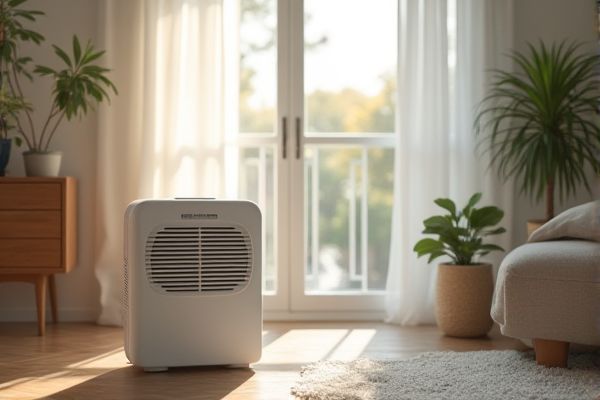
A dehumidifier reduces excess moisture in the air to prevent mold and mildew, while an air purifier removes airborne particles like dust, pollen, and allergens to improve indoor air quality. Understanding these differences can help you choose the right solution for your home environment; read on to discover which device suits your needs best.
Table of Comparison
| Feature | Dehumidifier | Air Purifier |
|---|---|---|
| Primary Function | Reduces indoor humidity levels | Removes airborne pollutants and allergens |
| Key Benefits | Prevents mold, mildew, and moisture damage | Improves air quality; reduces allergens and bacteria |
| Common Use Areas | Basements, bathrooms, damp rooms | Bedrooms, living rooms, offices |
| Air Filtration | No | Yes (HEPA, activated carbon filters) |
| Humidity Control | Yes, controls moisture levels | No |
| Typical Power Consumption | 300-700 watts | 20-100 watts |
| Noise Level | Moderate (40-60 dB) | Low to moderate (20-50 dB) |
| Maintenance | Empty water tank, clean filters | Replace or clean air filters regularly |
| Best For | Humidity control, preventing mold | Allergy relief, smoke and odor removal |
Dehumidifier vs Air Purifier: Key Differences
Dehumidifiers reduce excess moisture in the air, preventing mold growth and improving comfort, while air purifiers focus on removing airborne particles like dust, allergens, and pollutants to enhance air quality. Your choice depends on whether you need to control humidity levels or eliminate airborne contaminants for better health and indoor environment. Understanding these key differences helps you select the right device for your specific indoor air concerns.
How Dehumidifiers Work
Dehumidifiers work by drawing moist air over refrigerated coils, causing the moisture to condense and collect in a tank, effectively reducing indoor humidity levels. This process prevents mold growth and improves comfort by maintaining an optimal moisture balance. Unlike air purifiers that filter airborne particles, dehumidifiers specifically target and remove excess water vapor from the air.
How Air Purifiers Work
Air purifiers remove airborne contaminants by drawing air through filters such as HEPA, activated carbon, or UV light chambers that trap or neutralize particles like dust, pollen, smoke, and bacteria. Unlike dehumidifiers, which focus on reducing humidity levels by extracting moisture from the air, air purifiers primarily target pollutants to improve indoor air quality. Effective air purification can reduce allergens, odors, and airborne pathogens, promoting healthier respiratory environments.
Benefits of Using a Dehumidifier
Using a dehumidifier reduces indoor humidity levels, preventing mold growth and alleviating allergy symptoms by minimizing dust mites and other allergens. It protects furniture and building structures from moisture damage, enhancing the longevity of household items and maintaining a healthier living environment. Improved air quality and comfort result from balanced humidity, which also helps reduce respiratory issues and creates a more pleasant atmosphere.
Benefits of Using an Air Purifier
An air purifier effectively removes airborne pollutants such as dust, pollen, smoke, and pet dander, improving indoor air quality and reducing allergy symptoms. It can eliminate harmful bacteria, viruses, and mold spores, creating a healthier living environment. Advanced air purifiers with HEPA filters and activated carbon filters also help neutralize odors and volatile organic compounds (VOCs), enhancing respiratory health.
Dehumidifier or Air Purifier: Which One Do You Need?
Choosing between a dehumidifier and an air purifier depends on your indoor air concerns; a dehumidifier reduces excess moisture to prevent mold and mildew, while an air purifier removes airborne particles like allergens, dust, and pollutants. For those struggling with high humidity levels above 60%, a dehumidifier is essential to maintain comfortable and healthy air quality. Conversely, if airborne contaminants or allergens trigger respiratory issues, investing in a HEPA-filter air purifier is the optimal solution for cleaner, fresher air.
Impact on Indoor Air Quality
Dehumidifiers reduce indoor humidity levels, preventing mold growth and dust mite proliferation, which enhances air quality significantly. Air purifiers filter airborne particles such as pollen, pet dander, and smoke, directly removing contaminants from the air you breathe. Choosing between a dehumidifier and air purifier depends on whether your primary concern is controlling moisture or filtering pollutants to improve indoor air quality.
Health Benefits: Allergies, Asthma, and Respiratory Issues
Dehumidifiers reduce moisture levels, preventing mold growth and dust mites that trigger allergies, asthma, and respiratory problems. Air purifiers filter airborne pollutants, allergens, and pet dander, improving indoor air quality and reducing asthma symptoms. Your choice depends on whether moisture control or particle removal is the priority for managing respiratory health.
Energy Efficiency and Maintenance
Dehumidifiers typically consume more energy than air purifiers because they actively remove moisture from the air, which requires a refrigeration cycle. Air purifiers generally have lower maintenance costs, often needing only periodic filter replacements, while dehumidifiers require regular cleaning of water collection tanks and coils to prevent mold buildup. Energy-efficient models for both devices are available, with Energy Star certifications indicating reduced power consumption and optimized performance.
Choosing the Right Device for Your Home
A dehumidifier effectively reduces excess moisture, preventing mold and improving air quality by controlling humidity levels, while an air purifier filters airborne particles such as dust, pollen, and allergens, enhancing respiratory health. Your choice depends on whether your primary concern is dampness or airborne contaminants; if mold or musty odors are present, a dehumidifier is ideal, whereas for allergies and pollution, an air purifier is more beneficial. Evaluating your home's air quality issues and specific needs ensures you select the right device to create a more comfortable and healthy living environment.
 homyna.com
homyna.com